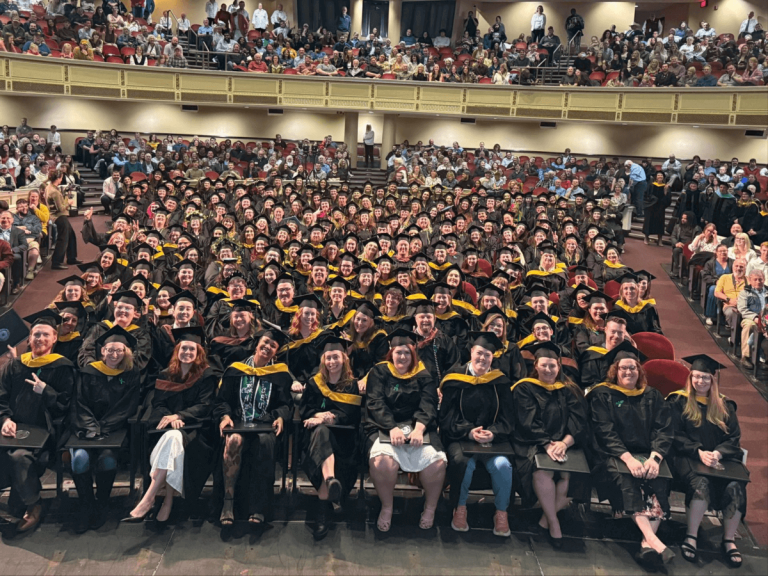Unity College students are now capturing black bears in central Maine as part of the first black bear study in the United States designed for undergraduate student involvement.
“The first bear was caught on Saturday, May 11, in Newburgh, Maine,” explained George Matula, Associate Professor and project leader for the bear study at Unity College. The seven-person capture team is led by Lisa Bates, Assistant Project Leader and a 2008 graduate of Unity College.
Bates first trained the student team on the overall process and intricacies of safely anesthetizing and handling a bear. The bear was captured in a culvert trap, a heavy-duty live trap designed specifically for capturing bears. Bates and several members of the capture team placed the trap in an area known for visits by bears.
“We got a phone call at 9:30 in the morning by a resident in the area that the trap was closed,” noted Matula. Bates and the students responded. They anesthetized the bear, collected biological measurements, removed a tooth to determine the age of the bear, put ear tags on the bear, collected fur samples for DNA analysis, and collected blood for hematological and DNA analyses. They also tattooed the inside of its lip for future identification, examined the bear for ticks, and assessed the bear’s overall physical condition.
“The process carefully addressed the health of the bear at every stage,” Matula said. “Students continuously monitored the bear’s vital signs, including heart rate, respiration rate, temperature, and capillary refill time.”
The bear was released unharmed.
During the morning of May 16, Bates received a call about a second bear that had been trapped, this time the town of Wales. By late morning, she was on scene with some students who are participating in the study.
Unity College began the ground breaking, multi-year Unity College Black Bear Study at the environmental college during September 2012. The study involves both faculty and students and includes the trapping, radio tracking, and in at least one case, attachment of a video camera to a Maine black bear.
The study is permitted by the Maine Department of Inland Fisheries and Wildlife (MDIFW), and is designed to collect data similar to what MDIFW gathers in their three study areas. “MDIFW has been studying Maine black bears dating back to 1975,” Matula said. “The Unity College Black Bear Study provides opportunities for students to get involved in real-life, large mammal research and management that is unique for undergraduate students.”
Trapping of bears began in May, with Matula and Bates leading students. They will place GPS / satellite collars on up to five adult female Maine bears. One of the collars will be equipped with a video camera.
“We are collecting data in areas not being covered by the MDIFW,” said Matula. “Our goal is to determine whether there are differences between bears in our study area and bears in MDIFW’s three study areas. The differences may include home range size of the bears, birth and mortality rates, and dispersal of offspring.” The Unity study will also determine if bear habitat in the Unity College study area is different from habitats in MDIFW’s three study areas, and whether those differences translate into differences in the bears’ biology and movement patterns.
The radio collars will provide information on the home range size of the bears, and whether they occasionally move far afield from their normal range. Information on habitat use, survival, and time of denning will also be gathered from the collars.
During winter months, Unity College researchers will go to dens of collared females to determine if they had cubs and if so, how many. They will tag the cubs, replace the mother’s radio-collars as needed, and collect biological data.
“The tagged cubs will stay with the mother for another year,” said Matula. “Bears generally only have cubs every other year. We will go back into the dens the next year to determine the minimum number of cubs that survived to become yearlings, and while we’re there, we will radio-collar the female offspring.”
The video camera placed on one of the bears will be removed and sent to the manufacturer for retrieval of the footage. Student researchers will download and analyze the data.
Matula says that student research teams have been created to work on specific aspects of the study. For example, members of the culvert trap team worked with the Unity College Student Government Association, which ultimately agreed to finance the purchase of a culvert trap. The landowner team has been working to obtain landowner permission to trap on their land. Other teams are helping to plan the study, design databases, conduct GIS analyses, deploy hair snares, design protocols for DNA analysis for bear hair, and establish a reference hair collection. Teams are also developing protocols for blood collection and analyses, scat collection and analyses, biological measurements, video-cam deployment, and other aspects of the study. They are now pre-baiting for bears and setting hair snares. Twelve student interns and volunteers will serve full-time on the study from mid-May to the end of June. Seven members will be trapping and handling bears, while the others will be scouting new areas, pre-baiting, working with landowners, processing biological samples, and maintaining databases. Matula and Bates will lead this effort.
In service to Unity’s trans-disciplinary approach to ecological problem solving, some students participating in the study will also apply their work with other classes. For instance, students in Instructor Kathleen Dunckel’s applied GIS course have developed a black bear habitat suitability model, and Assistant Professor Cheryl Frederick is guiding students as they develop protocols for scat collection and analyses, and for video footage analyses. Assistant Professor Brent Bibles is helping students design hair snare protocols; he plans to use data collected from the snares in his advanced wildlife courses. Professor Tom Mullin is working closely with the outreach team to develop outreach materials, develop a website, and initiate a Facebook page. “Creating outreach materials for the general public is an important part of the Unity study,” Matula noted. “The MDIFW is receiving more nuisance complaints about black bears in central Maine, so they welcome creation of materials that help the public understand they can easily and safely co-exist with bears.”
The general public is encouraged to call any bear sightings in to the Unity study at 207-948-9269, or e-mail jwhelan@unity.edu. “The information received will help us focus our research efforts,” said Matula.
In recent years Unity College has gained national attention for a variety of achievements including its focus on sustainability science, the leading-edge of 21st century ecological problem solving and the vanguard in the fight for the mitigation of global climate change; its ground-breaking “green” innovations such as the award-winning TerraHaus, the first student residence on a college or university campus built to the Passive House standard, the most energy efficient building standard in the world; and for being the first college in the United States to divest from investments in fossil fuels, igniting a growing national movement in higher education.
Unity College is a private college in rural Maine that provides dedicated, engaged students with a liberal arts education that emphasizes the environment and natural resources. Unity College graduates are prepared to be environmental stewards, effective leaders, and responsible citizens through active learning experiences within a supportive community.
(Image: Lisa Bates leads the research team at a capture site in Newburgh, Maine. Photo by Andy Reed.)



